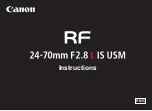
8
•
To avoid damaging your lenses, handle them with your fingertips, and be careful to avoid contact with your
fingernails. It is helpful to keep your fingernails short and smooth.
•
Start off correctly by getting into the habit of always using proper hygienic procedures so that they become
automatic.
Handling The Lenses
Develop the habit of always working with the same lens first to avoid mix-ups.
Remove the lens from its storage case and examine it to be sure that it is moist, clean, clear,
and free of any nicks or cracks.
Placing The Lens On The Eye
Work over a table, upon which is placed a clean towel. Do not place lenses on the eye while working over a sink.
For the right eye:
•
Wet your right index finger with a drop of conditioning solution and place the contact lens front side down on
your right index finger.
•
Place the second finger of the left hand on the middle of the upper lid and press
upward firmly.
•
Place the second finger of the right hand on the lower lid and press downward firmly.
•
Stare into a mirror as though looking through the second finger holding the contact
lens. You will later learn to do this without a mirror.
•
Slowly move the hand to advance the forefinger with the contact lens towards the cornea until the lens touches
the cornea and release the lids.
•
Release the lid and close the eye for a few seconds.
Repeat this procedure for the left eye.
There are other methods of lens placement. If the above method is difficult for you, your eye
care practitioner will provide you with an alternate method.
Note: If after placement of the lens your vision is blurred, check for the following:
1.
The lens is not centered on the eye (see "Centering the Lens", next section in this
booklet).
2.
If the lens is centered, remove the lens (see "Removing the Lens" section) and check for
the following:
a.
Cosmetics or oils on the lens. Clean, rinse, disinfect, and place on the eye again.
b.
The lens is on the wrong eye.
If you find that your vision is still blurred after checking the above possibilities, remove both
lenses and consult your eye care practitioner.




















